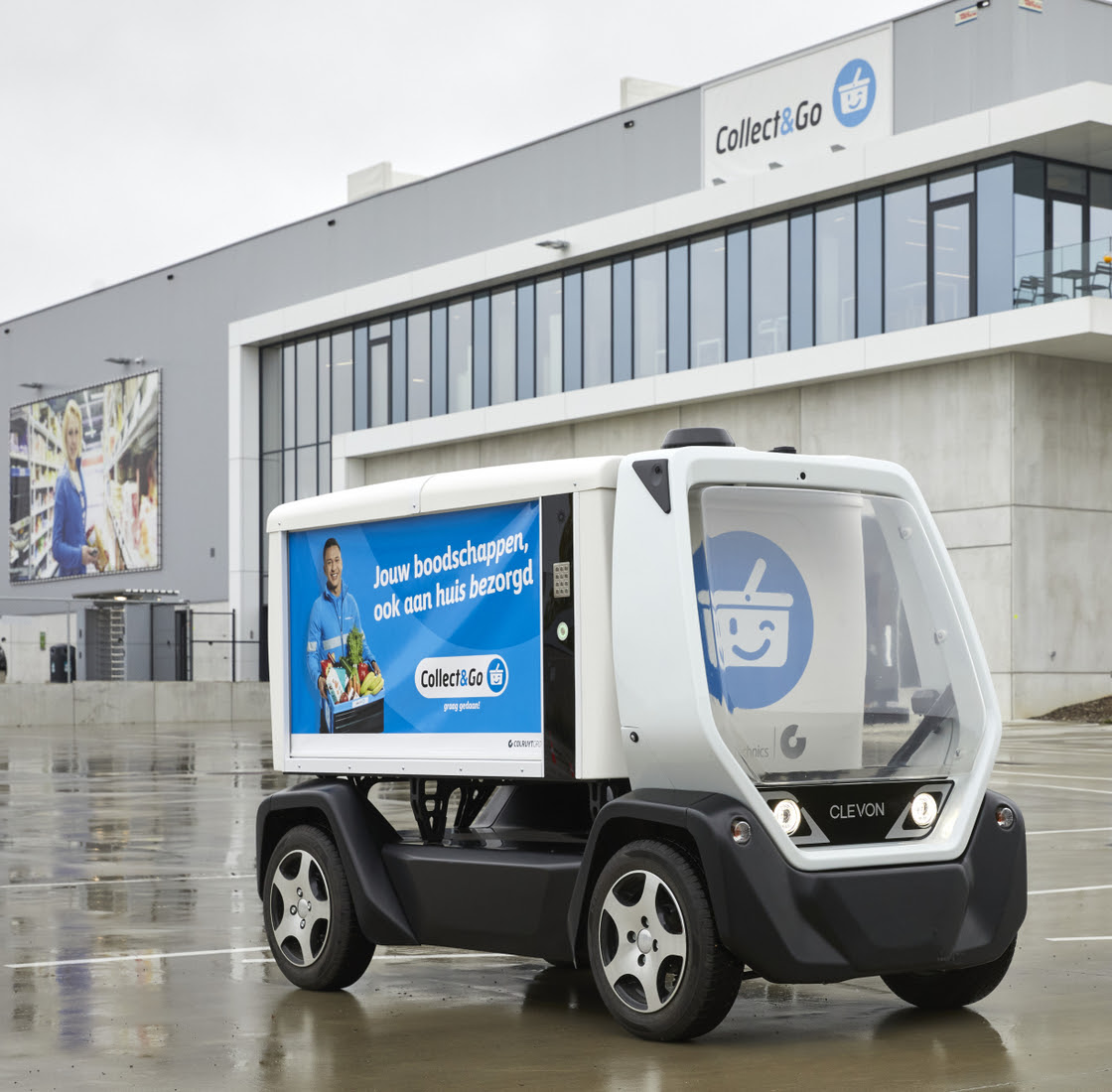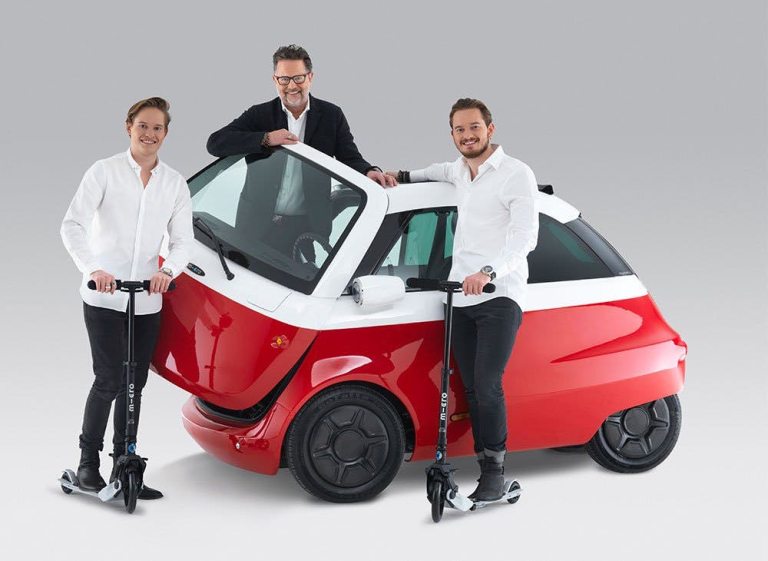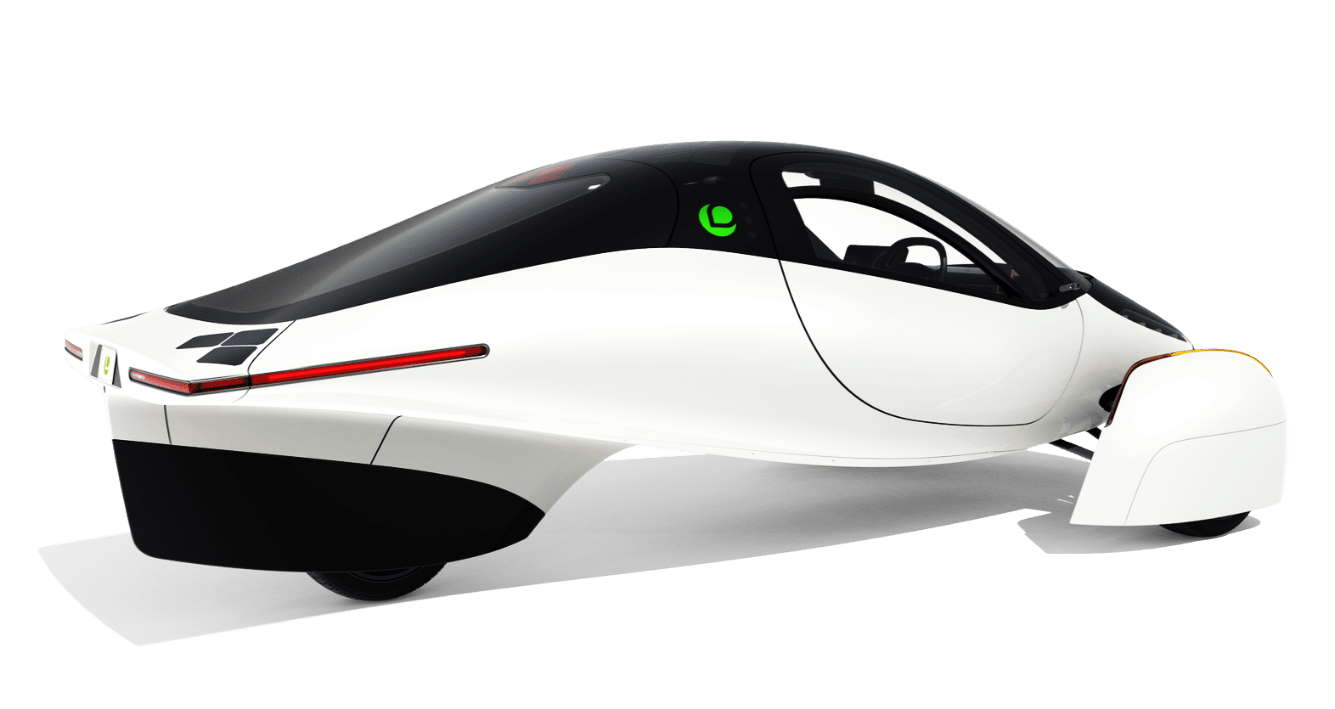After internal testing, the “CLEVON 1” takes to the public road in Londerzeel:
Belgium’s longest route without a driver.
Collect&Go, Colruyt Group‘s online shopping service, is currently testing the state-of-the-art technology: a vehicle built by the Estonian technology company Clevon that combines remote teleoperation with advanced autopilot functionality. The aim is to find out what such a vehicle can mean for Collect&Go in a rapidly changing e-commerce context. Remotely controlled, the self-driving vehicle will take to public roads for the first time today. In doing so, it will cover a 4-kilometre route, from the distribution centre to Collect&Go’s pick-up point in Londerzeel. This is the longest route ever covered in Belgium by an unmanned vehicle.
Focus on innovation: thorough testing of a special technology
The first test runs of the CLEVON 1 vehicle, a technological “tour de force” developed by the Estonian company Clevon, took place in recent weeks on the parking lot of the distribution centre in Londerzeel. Today follows a test in which the unmanned vehicle makes a delivery to the Collect&Go collection point in Londerzeel. With a journey of about 4 kilometres, that is immediately the longest stretch on public roads in Belgium for a remotely controlled device. Kim Vancauwenberghe, Managing Director of Colruyt Group Smart Technics comments: “In this first phase, we mainly want to test the technology, study what the vehicle is already capable of and see how, together with the local and federal government, we can provide not only safe, but also ecological transport on public roads in an urban environment. The tests not only provide useful insights for the online shopping service Collect&Go. Other formulas in our group are also following the study with great interest.”
The Smart Technics innovation team is the driving force behind other recent innovations within Colruyt Group. Just think of OKay Direct, an innovative 24/7 automated shop concept, and the Smart Fridges, the smart vending machines operated by Solucious and found in all Jims gyms. The innovation team will therefore test the remotely controlled unmanned vehicle thoroughly before making any statements about its deployment for last-mile delivery in cities.
E-commerce is a fast-growing and competitive market, capitalising on the trend of ecological electric transport in densely populated areas worldwide. Colruyt Group also sees opportunities. Especially for Collect&Go which, as market leader in Belgium, started home delivery in cities in June 2022. That is why a conscious choice was made for a test with a compact, all-electric vehicle that has sufficient storage space and can be closed with a numerical or QR code.
Tom De Prater, business unit manager for Collect&Go confirms the interest: “Online grocery shopping is an important pillar for Colruyt Group and it is our ambition to be and remain best of class in this. In a rapidly changing e-commerce context, we are therefore constantly looking for ways to organise the ‘last mile’ as efficiently and sustainably as possible. There is already a worldwide shortage of drivers, the cost of those last kilometres is sky-high and mobility in cities is a real challenge. Investing in innovation, new solutions and state-of-the-art technologies is therefore crucial. This pilot project obviously fits in with that. We are enthusiastic about the potential, at the same time we are very realistic and will proceed step by step.”
| Longest route in Belgium Collect&Go will be the first service in Belgium to test electric unmanned vehicles on public roads in Belgium, it is the first time a car without a physical on-board driver has taken to the road. Previous tests with unmanned vehicles did involve someone on board. Of course, this ride is organised in complete safety: whereas the CLEVON 1 drives completely autonomously during the test in the Collect&Go car park, for the ride on the public road it is remotely controlled by a teleoperator. The mayor of Londerzeel and local police forces are also closely involved in this pilot project. They are responsible for safety and guidance along the route. Conny Moons, Mayor of Londerzeel emphasises: ”As mayor of Londerzeel, I am immensely proud that our municipality can contribute to this technological tour de force. With the entire municipal council, we highly value innovation, and we like to encourage projects that work around it. Collect&Go has become a permanent value in our region since the distribution centre was opened, so the picture fits for us.” Sander Sebastian Agur, CEO of Clevon, is confident that the test will also go smoothly in Belgium: “Our third-generation autonomous driving vehicle CLEVON 1 has the necessary permits to drive on public roads in Estonia and Lithuania. Licence applications are pending in the United States and many other European countries. Our driverless, all-electric vehicles have already been in city traffic for 2.5 years with an impeccable safety record, proving that the technology is functional and safe for everyone around.” In addition, a licence was needed from the Federal Government Dept. Mobility to run a remote controlled car on public roads, even if it was a well-supervised test. VIAS, the Belgian road safety institute, mapped all possible risks to this end. Colruyt Group, the local and federal government thus left nothing to chance. With the permit from the Federal Government Mobility and the insurance with AG, the remotely driven car is today ready for its ‘maiden voyage’ in Londerzeel. Georges Gilkinet, Federal Minister for Mobility adds: “Self-driving cars are an additional mobility choice, which can usefully complement existing public transport. Together with the regions and the sector, I want to establish a regulatory framework for the development of self-driving cars. That is why we support these tests. For the logistics sector, the self-driving car has interesting potential, but it is not the only option to be further developed for the future. Cargo bikes for the last mile or rail for long distances also still have a lot of potential as competitive transport solutions. After all, a self-driving car stands still in traffic jams just as well as a classic car.” Liability insurance for the vehicle was taken care of by AG, which had previous experience with such projects. Edwin Klaps, managing director Non-life: “AG wants to play an important role in the mobility of the future. This new phase of autonomous vehicles is a good opportunity for us to follow new evolutions closely, gain experience with them and collect data that we can use in the evaluation of risks. Hence our role as insurer in this project.” |
| How it works: ingenious technology from Estonia The CLEVON 1 vehicle works on the basis of vision technology, machine learning and sensors. In a suitable controlled environment, the vehicle, which can travel up to around 50km/h (but is agreed to keep it under 25 km/h for the initial test phase), can be operated in the autopilot mode. During this, a large number of general driving tasks will be performed by the vehicle autonomously with the teleoperator supervising the vehicle at all times. The teleoperator can also take over the control of the vehicle at any given time to ensure the highest level of safety. To observe its surroundings, it uses three front cameras, two side cameras and one rear camera. Beside the cameras, the vehicle is also equipped with short- and long-range radars, which can measure distances and recognise and identify “obstacles” such as cars, cyclists and pedestrians, among other things. In this way, it has a clear field of view of its surroundings and can predict and thus avoid possible collisions in traffic. Clevon uses multiple deep neural networks, fusing together camera and radar information which allows the vehicles to detect and identify the dynamic environment. The technical team in Estonia is constantly developing and improving the vehicle, so eventually in the future, one teleoperator could manage five to ten vehicles simultaneously. The CLEVON 1 communicates via 4G with the operator in the control room. Kim Vancauwenberghe of Smart Technics: “Reliable data connectivity is crucial for this technology. To be sure, the vehicle has 2 SIM cards from 2 different providers, so there is always a network available. In the unlikely event that both networks fail, the unmanned vehicle comes to a safe stop.” ***Colruyt Group operates in the food and non-food distribution sector in Belgium, France and Luxembourg with more than 700 own stores and approximately 580 affiliated stores. In Belgium, this includes Colruyt Lowest Prices, OKay, Bio-Planet, Cru, Dreamland, Dreambaby, Bike Republic and the affiliated Spar stores. In France, in addition to Colruyt stores, there are also affiliated Coccinelle, CocciMarket and Panier Sympa stores. The group is a majority shareholder of The Fashion Society, which includes the fashion retail chains ZEB, PointCarré and The Fashion Store. JIMS operates fitness clubs in Belgium and Luxembourg. Solucious and Culinoa deliver food service and retail products to professional customers in Belgium (hospitals, SMEs, hospitality sector, etc.). The activities of Colruyt Group also comprise energy supply by DATS 24 in Belgium (fuels, natural gas and green energy) and France (fuels), and printing and document management solutions (Symeta Hybrid). The group employs over 32.000 employees and recorded a EUR 10,0 billion revenue in 2021/22. Colruyt is listed on Euronext Brussels (COLR) under ISIN code BE0974256852 Clevon develops multifunctional autonomous vehicles that help make home delivery of goods cheaper, faster, more customer-friendly, and more environmentally friendly. The company has offices in Estonia and the US, Texas. Clevon provides services with CLEVON 1 in Estonia, Lithuania, and now Belgium. In 2022, Clevon was listed on the Nasdaq’s North Baltic Exchange (CLEV) under ISIN number EE3100096884 after spinning off from Cleveron. |



